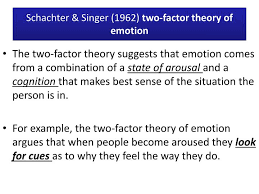Schachter-Singer Theory – Psychology Notes – For W.B.C.S. Examination.
স্ক্যাচার-সিঙ্গার থিয়োরি – সাইকোলজি নোট – WBCS পরীক্ষা।
Cognitive theories of emotion began to emerge during the 1960s, as part of what is often referred to as the “cognitive revolution” in psychology. One of the earliest cognitive theories of emotion was one proposed by Stanley Schachter and Jerome Singer, known as the two-factor theory of emotion.Continue Reading Schachter-Singer Theory – Psychology Notes – For W.B.C.S. Examination.
Schachter and Singer’s Experiment
In a 1962 experiment, Schachter and Singer put their theory to the test. A group of 184 male participants was injected with epinephrine, a hormone that produces arousal including increased heartbeat, trembling, and rapid breathing. All of the participants were told that they were being injected with a new drug to test their eyesight. However, one group of participants was informed of the possible side-effects that the injection might cause while the other group of participants was not.
Participants were then placed in a room with another participant who was actually a confederate in the experiment. The confederate either acted in one of two ways: euphoric or angry. Participants who had not been informed about the effects of the injection were more likely to feel either happier or angrier than those who had been informed. Those who were in a room with the euphoric confederate were more likely to interpret the side effects of the drug as happiness, while those exposed to the angry confederate were more likely to interpret their feelings as anger.
Schacter and Singer had hypothesized that if people experienced an emotion for which they had no explanation, they would then label these feelings using their feelings at the moment. The results of the experiment suggested that participants who had no explanation for their feelings were more likely to be susceptible to the emotional influences of the confederate.
Criticism of Two-Factor Theory
While Schachter and Singer’s research spawned a great deal of further research, their theory has also been subject to criticism. Other researchers have only partially supported the findings of the original study and have at times shown contradictory results.
In replications by Marshall and Zimbardo, the researchers found that participants were no more likely to act euphoric when exposed to a euphoric confederate than when they were exposed to a neutral confederate. In another study by Maslach, hypnotic suggestion was used to induce arousal rather than injecting epinephrine. The results suggested that unexplained physical arousal was more likely to generate negative emotions no matter which type of confederate condition they were exposed to.
Other criticisms of the two-factor theory:
- Sometimes emotions are experienced before we think about them.
- Other researchers have supported James-Lange’s initial suggestion that there are actual physiological differences between emotions.
Please subscribe here to get all future updates on this post/page/category/website


 +919674493673
+919674493673  mailus@wbcsmadeeasy.in
mailus@wbcsmadeeasy.in







































































































